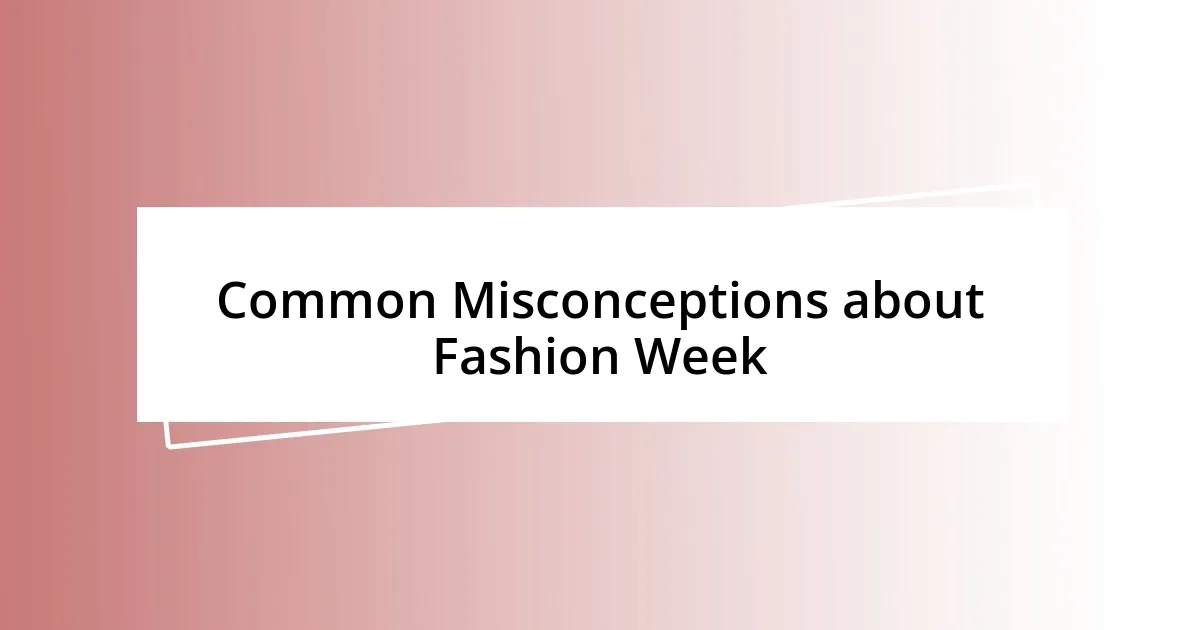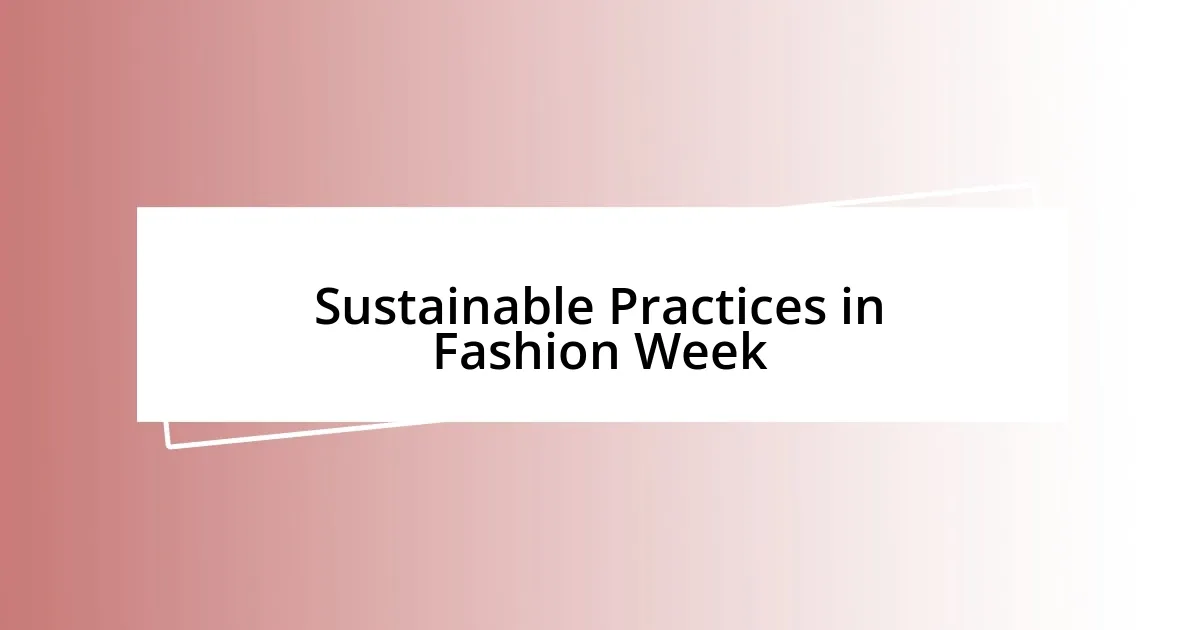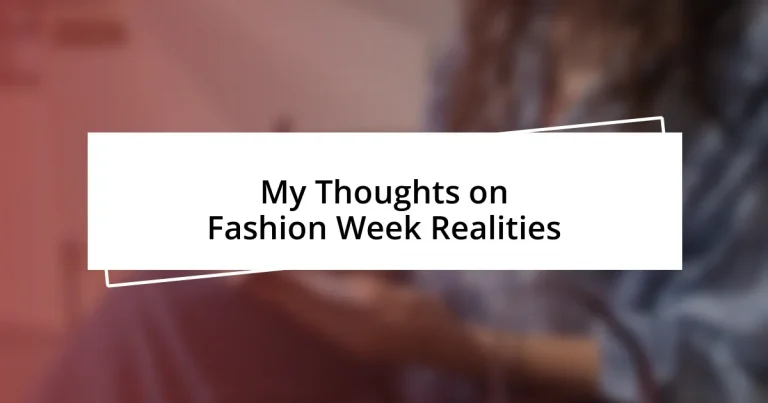Key takeaways:
- Fashion Week combines creativity and commercialism, showcasing designers’ hard work and passion behind each collection.
- It significantly influences trends and consumer behavior, acting as a mirror reflecting societal moods and cultural shifts.
- Misconceptions about Fashion Week include its perceived exclusivity and instant success, whereas it involves extensive behind-the-scenes efforts and continuous evolution based on feedback.
- Sustainability is becoming central to Fashion Week, with designers embracing eco-friendly practices and transparency in their supply chains.

Fashion Week Overview
Fashion Week is not just a series of runway shows; it’s a living, breathing spectacle that encapsulates the pulse of contemporary fashion culture. I remember my first experience attending Fashion Week—it felt electric, a platform where creativity collided with commercialism in a whirlwind of colors and textures. Can you imagine the energy in the air, where every beat of the music and flicker of the lights tells a story?
Behind the glamour lies a remarkable amount of hard work and preparation. Designers pour their souls into their collections, often at the expense of sleep and sanity. I’ve seen firsthand how stress can weave itself into the fabric of preparation, creating pieces that are works of art but also a testament to pushing oneself to the limits. Isn’t it fascinating how passion can be both a driving force and a source of anxiety?
Then there’s the audience—the influencers, the buyers, the curious onlookers—all there to witness the narrative unfolding before them. I’ve often found myself struck by the diversity of perspectives; each person interprets the same collection in a entirely different light. Have you ever noticed how one outfit can evoke an array of emotions, sparking conversations that linger long after the show has ended?

Significance of Fashion Week
Fashion Week plays a pivotal role in shaping industry trends and influencing consumer behavior. I’ve often thought of it as a mirror, reflecting what we crave and aspire to wear. Each collection showcases not only the designer’s vision but also responds to the societal moods and cultural shifts happening around us. I’ve experienced firsthand how the excitement of a collection launch can ripple through social media, setting off a frenzy of interest and anticipation.
- It ignites creativity, inspiring both established designers and new talent.
- It serves as a barometer for the prevailing social and political climate.
- It connects industry insiders, fostering collaborations and organic networking.
- It also helps elevate visibility for emerging designers, offering them a chance to shine on a global platform.
This blend of significance creates an atmosphere charged with potential and opportunity. I can still recall the thrill I felt watching a brand I admire transition from a quiet studio to the runway; it was as if a door opened to endless possibilities, igniting dreams for many hopeful designers in the audience.

Common Misconceptions about Fashion Week
Many people believe that Fashion Week is solely about glamorous models walking down the runway. In reality, it’s so much more than that. I remember being in the front row, feeling the intensity as designers and their teams worked tirelessly behind the scenes. The preparation involves countless fittings, last-minute alterations, and even a few tears along the way. It’s the unsung heroes — the backstage crew, makeup artists, and seamstresses — who truly bring the vision to life.
Another common misconception is that every collection is an instant success. In truth, many pieces evolve dramatically after the show, thanks to the feedback from critics and consumers alike. I’ve seen designers take notes during their presentations, their minds churning with ideas for improvement or adjustments based on the audience’s reactions. This responsiveness is what allows fashion to remain dynamic and reflective of what people truly want to wear.
Many also think that Fashion Week only caters to the elite. However, I’ve found that social media democratizes fashion, allowing wider audiences to engage with the collections. While I’ve walked the streets post-show, I often chatted with local fashion lovers who interpreted trends in their unique ways. The buzz on platforms like Instagram enables everyone to participate in the conversation, making the entire experience more inclusive.
| Misconception | Reality |
|---|---|
| Fashion Week is only about glamorous runway shows | It’s a complex event involving extensive behind-the-scenes work from designers and their teams. |
| Every collection achieves immediate success | Designers often refine their pieces after receiving feedback during and after the shows. |
| Fashion Week is exclusive to the elite | Social media allows anyone to engage with and interpret fashion, making it more accessible. |

Sustainable Practices in Fashion Week
Sustainable practices at Fashion Week are becoming increasingly vital, and it’s fascinating to see how some designers are leading the charge. For instance, I saw this firsthand when a prominent brand unveiled a collection made entirely from recycled materials. The excitement in the room was palpable. It made me wonder – if fashion can evolve in such a radical way, what’s stopping others from following suit?
During one of the events, I stumbled upon a pop-up shop featuring pieces created with zero waste principles. The thought that every scrap of fabric could be transformed into something beautiful really struck me. How amazing is it that innovation and sustainability can go hand in hand? It’s inspiring to witness entire collections built on the backbone of eco-friendliness, encouraging both consumers and other designers to think more sustainably.
Additionally, I’ve noticed some brands actively promoting transparency in their supply chains, which is pivotal for fostering trust. I recall speaking with a designer who openly shared where their fabrics were sourced and how workers were treated. Their commitment resonated with many in the audience, including myself. It raised an important question: as consumers, shouldn’t we demand this level of transparency from all brands? These steps toward sustainability are more than just trends; they signal a much-needed shift in the fashion industry’s future.

Personal Reflections on Fashion Week
Experiencing Fashion Week up close always leaves me with a mix of awe and reflection. When I attended my first show, the electric atmosphere was overwhelming. I could feel the whispers of expectations hanging in the air, and it made me appreciate just how much hope designers invest in each collection. It’s not merely about the clothes; it’s about dreams coming to life under the spotlight.
What struck me, though, was the emotional weight behind each piece showcased. I remember standing near a young designer whose hands trembled slightly as their collection debuted. Their excitement was palpable, yet I could see the fear of vulnerability in their eyes. It made me realize that behind the glitz, there are real people pouring their hearts into their work, hoping the world will embrace their vision.
I often ponder the impact these seasonal showcases have on the broader fashion landscape. When I think about the designers I met, many emphasized the importance of storytelling through their collections. It’s more than just fabric and stitches; it’s an invitation to connect emotionally with the audience. Isn’t it fascinating how a single outfit can evoke memories or feelings? Walking away from those events, I’m usually left questioning how each collection influences me personally and shapes the narratives we’ll wear in our everyday lives.














